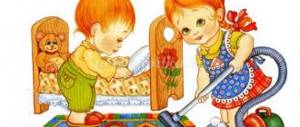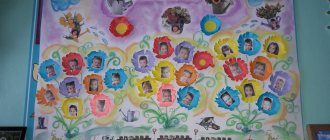Tasks and goals of labor education of preschool children
The labor education of children begins from preschool age, when children copy adults and imitate them with great desire. The main thing is not to miss this moment, to encourage any desire of the child, and also to interest him for further activities. The main goal of labor education of a preschooler is the formation of a reverent attitude towards work, as well as an understanding of adult work.
Main tasks of labor education:
- Show the child how important work is in life, form a correct idea of the work of adults
- Teach the necessary skills for work
- Develop a caring attitude towards work
- Tasks that help develop qualities such as responsibility, hard work, caring
The importance of work for personal development
Many mothers and fathers underestimate child labor, explaining this by the fact that their child will still have time to work at an older age. However, as is already known, labor skills begin to develop from an early age.
Labor activity contributes to the development of endurance, patience, responsibility, willpower, and also develops the child’s independence and desire to achieve certain goals and objectives.
The preschooler begins to realize that work, in addition to joy, can also bring quite a few troubles associated with complex, tedious and boring work.
By helping parents with everyday matters (washing the floor, washing dishes), the child learns to understand that if such work is not done very efficiently and accurately, then it is unlikely that anyone will like it. By running errands for adults, the baby shows love for loved ones.
If you ask a child to fix a toy, this does not mean that you need to resort to any specific mechanical actions. Such work forms the development of initiative, memory, imagination, the child strives to find a way to solve the problem. Also, working with small parts, the child develops fine motor skills, which in turn is very useful for speech and intelligence.
Forms and types of labor education
Labor education of preschool children in the family helps in physical and moral development. By mastering work skills, children begin to become more confident. Work develops a sense of discipline.
The types of work activities depend on the goals and objectives of the work. By watching adults, children learn work and certain abilities.
Types of labor education
Self-service
This skill must be developed in a child from an early age. But due to the characteristics of a small organism, babies are not yet able to perform various actions: their fingers do not obey, the sequence of actions is not remembered, the inability to control their own will. During this period, adults need to be patient and calm, and be supportive of the baby. This is the only way to get a positive reaction from the child to perform such actions as brushing his own teeth, getting dressed, making the bed, putting away toys.
In order for your child to quickly master self-care skills, you need to:
- Perform these actions constantly
- Monitor the execution of work processes
- Teach your child neatness, cleanliness, neatness
As you get older, add new self-care responsibilities. For example, for a primary school student, work together to prepare school clothes for tomorrow, then allow the child to do it independently, controlling the process.
Household labor
Preschool children need to acquire economic skills. You can entrust your child with simple tasks such as wiping dust, tables, and cleaning toys. In kindergarten, similar work methods apply: while on duty, children set the table, take care of the plants, and wipe the shelves. For every action of the child, it is necessary to praise and encourage him, even if the result of the work performed is not entirely satisfactory. Adults control all actions and, if necessary, correct the child, thereby showing how to properly perform this or that work. It is forbidden to scold children; this is the only way to achieve the goal of labor education.
Labor in nature
Developing working abilities in nature is a great way to experience all the splendor and beauty of the environment, develop skills such as observation and learn to hone your actions. The goal of this type of education is to develop endurance and strong-willed qualities.
Children can be entrusted with feeding birds, fish, and caring for flowers. If the group has a living area, then kids can take care of the animals. At home, children can be assigned the same responsibilities. Another interesting way is to grow greens on the windowsill (onions, dill, parsley). Kids will enjoy watching the growth of such plants and caring for them.
Manual labor
Manual labor means working with your hands. Preschool children make crafts using various materials. Manual labor contributes to the development of such qualities as patience, perseverance, and aesthetic taste. Here, as in any other type of work activity, it is important for the child to receive praise from adults in order to maintain interest in this activity.
Forms of labor education
There are three main forms of labor education:
- Errands. These are individual tasks that are assigned to the child by parents or kindergarten teachers. Here the characteristics of the baby and his experience are taken into account. By completing tasks, the child develops a sense of responsibility.
- Duty roster. This form of work activity is aimed at ensuring that the child completes tasks to serve the team (for example, setting the table). This teaches the child to care about others and to be responsible to the team.
- Teamwork. This form of work is more typical for older children: adults give a general task that must be completed within a certain period of time. Children learn to work in a team and negotiate.
Labor education in relation to different age groups
Preschool age is the best time to develop basic self-care skills, certain skills, and observation. With each stage, the load becomes more complex and requires appropriate actions from the guys. Adults need to remember about age-related characteristics, show patience and kindness, so as not to cause denial in the child.
- The child's fingers are not yet sufficiently developed and do not obey him well.
- The sequence of actions is also not given to the baby; it is difficult to remember everything the first time.
- A younger preschooler will not be able to attract volitional efforts to help; these abilities are still just being formed.
Teachers usually know which teaching methods are appropriate for each age group. They have the responsibility to give recommendations to parents so that children develop harmoniously.
Taking into account the physiological and psychological characteristics of pupils, you need to remember that for children 3-4 years old, the optimal duration of work is 10-15 minutes . Children aged 6-7 years do physical exercise for a maximum of half an hour. The condition of each baby must be monitored. Pay attention to sweating and redness of the skin, when they appear it is better to change your occupation. To prevent children from getting tired, it is better to move on to other activities after 10-15 minutes. When dosing them, be sure to take into account the volume of physical activity and its complexity.
Making a model according to traffic rules in kindergarten with your own hands
Labor education in the younger group
Children 3-4 years old are active, often talking about their desire to participate in one activity or another. But they get tired quickly, it is difficult for them to concentrate, so you should not overload them. The assignments of adults in the younger group are more individual in nature; the student will only need to hang up towels or arrange the cutlery for dinner.
Points to consider:
- labor education is situational in nature, for a three-year-old the main thing is that the tasks are simple and understandable;
- children should be praised for any success;
- In order for the child to understand the meaning of his actions, the teacher needs to explain the tasks and evaluate the results;
- Before doing anything, the child needs to observe how an adult copes with it; then the child’s actions follow with step-by-step comments from the teacher.
The main method of working on labor education with children 3-4 years old is personal example. The guys watch the actions of their elders, manual labor, various exercises are carried out in a playful way. Knowledge is consolidated through the example of such famous works as “Fedorino’s grief” or “Moidodyr”.
Labor education in the middle group
By the age of four, the baby will be able to handle sweeping paths or washing doll clothes. The tasks gradually become more complex, and the children already have some self-organization skills. They can be entrusted with duty in the dining room or preparing for classes; the children are quite capable of performing simple care for animals in a corner of nature.
In the working method it is important:
- note the child’s desire to help;
- the work is carried out in a playful way (application and design, rules of behavior in various situations are reinforced through role-playing games);
- visual aids are used;
- Conversations are held about the content of future actions and relationships.
Labor education in the senior group
Collective assignments are already being used with children aged 5-7 years. When interacting with each other, children learn to coordinate efforts, agree on something, and share responsibilities among themselves. Playing for children is still the main activity, but they meet the teacher halfway, help replace bed linen in the bedroom or collect leaves on the site.
It is important for the teacher to organize the workspace and equipment. Shovels and watering cans should be bright and comfortable to make children want to play with them. Elegant aprons will create a feeling of celebration. The duration of classes should not be overtiring.
?
The main goal of the labor development process in preschool educational institutions is to develop a respectful attitude towards the activities of adults, familiarity with the main professions, understanding of their significance, and the desire to help.
Labor education in the preparatory group
For older preschoolers, work takes on a systematic nature and becomes more numerous. Children repair books or boxes and sew buttons on their own. Under the supervision of the teacher, they prepare the necessary manuals for classes, counting material, and cut out specified elements from plastic bottles. The guys themselves notice the disorder in the area, water the flowers, and remove fallen leaves.
Planning a walk in a preparatory group in winter
In the seventh year of life, pupils help set the table for dinner, the attendants monitor the availability of soap and towels, the quality of hand washing, and look after the living area.
Methods and means of labor education
From an early age, children learn about the world around them, and the goal of parents is to help with this by teaching simple independent actions.
Labor education of young children is carried out using the following means:
- Own activities. With the help of this tool, kids learn and acquire certain skills, achieve goals and get results. They also develop hard work and discipline.
- Familiarization with the work of adults. This tool helps the child learn about the work activities of other people, about social significance, and forms the right attitude towards work.
- Artistic media. This includes various types of art: music, painting, etc. Of course, you cannot learn to work by listening to a fairy tale or music. However, this helps to interest the child. In most stories and fairy tales, the main characters are always hardworking, help those in need, and ultimately receive love and recognition. A child can experience emotions that make him want to be like someone who does work and is not afraid of work.
The main methods of labor education for preschool children include:
- Emotional mood method: use of musical works, discussion of work activities and results
- Verbal method: discussions, reasoning about the progress of work, methods of its implementation, evaluation
- Visualization method: the nuances of work are shown and demonstrated
- Practical tasks are work that is performed directly by the child himself.
Types and forms of employment in the preparatory group
Labor education runs a red line through all areas of educational activity in preschool educational institutions through the organization of different types of classes.
Orders
In this type of activity, two motives for work are realized at once: the desire to be useful and praise. Older preschoolers receive instructions from authoritative adults with great enthusiasm. And for the sake of praise, the desire to be useful, they do everything to complete the assignment well and as quickly as possible. For example, they remove toys from the playground after a walk.
Orders can be of three types:
- individual (the student is given the task of watering the ficus in a group);
- group (instructions are addressed to 2–4 children, for example, after a leisure activity, put the gaming material into boxes - dolls, cars, board games, sports equipment);
- general (all children in the group receive the task, for example, put away their writing utensils in a box, laying out pencils separately, pens separately, after the literacy lesson is over).
In the educational process, all types of tasks are combined, which is displayed when compiling a file of work assignments. This type of work activity is especially in dire need of encouragement. And not only for the worthy execution of the assignment, but also for the initiative and desire to provide assistance.
This is interesting. The assignment does not at all exclude the assistance of an adult in completing the task. Moreover, this approach creates in children a feeling of a strong shoulder and confidence in the help of others.
When running errands, it is important for a child to know that it will be beneficial, and the child will be praised
Duty
This type of work activity involves several (2–4) children receiving a specific task, the implementation of which requires a high degree of responsibility. Duties can be of the following types:
- in the dining room, which involves laying out cutlery, placing plates of bread on tables, etc.;
- around the territory, when after a walk the children cover the sandbox, collect the remaining toys, and sweep the paths;
- in preparation for classes, that is, the guys prepare sets of materials for each student in accordance with the educational direction of a particular lesson (paints, brushes, water, a rag, sheets of paper - for drawing with paints, etc.);
- in a corner of nature - children water flowers, pour food for fish, etc. (one of the methods of working in this type of work activity is “talking with animals, flowers,” when students thank the plants for flowering, wish them a good day, etc., which helps children understand the importance of attention and kind words for all living things).
Duties help unite a team of kids, teach them to take responsibility for their actions in front of the group, and also help them get to know each other better.
Joint work
This type of work activity is designed to develop in children the ability to coordinate their actions with the actions of their comrades, establishing a uniform pace of work. The product of joint activity is a common benefit: a cleaned area on the street, a group room decorated for the New Year. The essence of the lesson is that the teacher formulates a common task for the group, and then distributes responsibilities for its implementation. At the end, the results of this work are summarized.
In the course of joint work, preschoolers learn to negotiate and take into account the opinions of their comrades
From my own experience, I can say that I practice joint activities, for example, when preparing a group room for an open lesson. So, one child collects the toys necessary for the lesson, checking the set with the list that I gave him, the second lays out files with sets of materials on the tables, the third brings pencils to each table, the fourth wipes the dust on the shelves, etc. After At the end of the preparatory stage, I thank all the guys for their help and draw their attention to the fact that it will be convenient and pleasant for us to work in a clean and well-organized room.
This is interesting. Joint work presupposes children's dependence on each other and close contact. Therefore, it is important to select tasks so that students can fully complete their task. For example, Polina should not be assigned to work with Masha - she is distracted, and Misha should not be given the task of disassembling the construction set after the game, since the boy does not know how to work quickly, and besides, the toy will probably captivate him.
Video: example of organizing joint work activities in a preparatory group
Forms of work activity of older preschoolers
Work in the preparatory group is organized in the form:
- direct educational activities (in the classroom);
- leisure activities (outings, matinees, etc.);
- independent activities (usually in the form of instructions, for example, to remove the surroundings - dolls, a chair, toy dishes, etc. - after the game “Mothers and Daughters”).
In good weather, work activities are organized mainly outdoors
Features of labor education in the family
- Parents must set a good example. If mom and dad are constantly arguing about who will go take out the trash or wash the dishes today, then it will be difficult to teach the baby to work hard.
- Labor education should begin from an early age. Typically, children do not like to clean up their toys. In this case, do it together. All toys should have their place: books on the shelf, soft toys in the basket
- If your child wants to do something on his own, don’t interfere. Even if the child didn’t wash the plate well or gets dressed too slowly. Be patient and also assign certain simple responsibilities to your baby.
- Praise your child for anything he does. It is very important for kids to understand that they are great. Parents' admiration is the best reward
- There is no need to force a child to work. The best option is joint work. Turn ordinary cleaning into a game, a competition
- Entrust your baby with regular responsibilities according to his age: feeding pets, caring for flowers. This way the child will understand that his work is very important in the family.
- The child needs to understand the result of his actions. Explain to him why he is doing this or that work: if you don’t feed the fish, they will die, and flowers will wither without water
- Some instructions may not be clear to the child, so adults need to show the child exactly how to do the work. It will probably take some time for the child to understand. Be patient and repeat as many times as necessary
- Monitor your baby. If a child does not do the job well, and the parents then finish it or redo it for him, then in the future the child will shirk from completing assignments, knowing that they will do everything for him anyway
Fostering hard work in young children
To achieve success in life, a person must be hardworking. Nature did not instill such a quality in us, so love for work must be developed. The main task of labor education for preschoolers is to teach hard work and to be responsible for the task being performed.
Labor education of children of primary preschool age begins with self-service, or carrying out simple instructions from parents in everyday life. Older children perform educational and social work. The sooner parents begin to introduce their children to household work, the easier it will be for them to cope with their work responsibilities in the future.
Each child, like any person, has his own specific interests in certain activities. And if you do not pay attention to such interest and desire of the baby, and do not engage in further development, then this interest may disappear altogether. It is important for mom and dad to support the child, as well as add something new that will help develop hard work. Combine business with pleasure in the form of play, and your child’s work will be easy; he will be interested in helping not only himself, but also those around him.
Kids love to imitate adults, it’s important not to miss this moment. Let your baby help you with simple family tasks: putting toys away, wiping the table, washing a cup, and so on. Allow your child to be independent, especially if he wants it himself.
Don't forget about rest, a little person needs it. In between work activities, allow your child to do what he likes.
Labor education of girls
Girls need to be involved in household work: taught to clean the house, do laundry, cook simple meals, and set the table. Such activities should be unobtrusive and properly organized so that the baby becomes more and more willing to help her mother. The daughter needs to understand that they need her help. As you grow older, you need to add more complex tasks: handicrafts, caring for the younger ones.
Working together, mother and daughter develop mutual understanding. In the future, all this will have a positive impact on caring for elderly parents.
Labor education of boys
The best example for a son is his father. If dad sits on the couch all day long and does not help his wife, then most likely the boy will not grow up to be a hard worker.
Depending on the age of the baby, dad can assign various work activities: helping during the repair of any items, giving tools, assisting with work in the garden or garage. A common cause promotes rapprochement and improvement of relationships. Repairing some simple household appliances can be turned into an interesting activity, stimulating the child’s greater interest.
Card file of work assignments for children of the preparatory group
Ekaterina Smirnova
Card file of work assignments for children of the preparatory group
Task No. 1
"Watering indoor plants"
.
Goal: to expand children’s about the needs of plants for light and moisture, to teach how to recognize moisture-loving and drought-resistant, light-loving and shade-tolerant plants by their leaves. Develop accuracy when working with water and plants, confidence in your actions, work skills . Foster a caring attitude towards the natural environment and a desire to take care of it.
Task No. 2
"Washing houseplants"
.
Purpose: to give children an idea of watering methods (in a tray, under leaves)
and rules
(do not flood, water evenly)
;
cultivate a desire to care for plants. Involve children in all possible help , clarify children’s about indoor plants.
Task No. 3
“Spraying indoor plants with water from a spray bottle”
.
Goal: teach a new work skill ; reinforce children’s that leaves also need moisture; cultivate a caring attitude towards plants. Teach children to independently determine the need for watering (by the color and condition of the soil, by the appearance of the plant, recall the watering technique.
Task No. 4
“Green landing on indoor plants”
(remove diseased leaves, fertilize)
.
Goal: to teach children to determine by the condition of indoor plants what actions are necessary to care for them (watering, cleaning, loosening, fertilizing, correctly perform the relevant labor operations , invite the children to tell about the purpose of each of them.
Task No. 5
"Taking care of plants"
.
Goal: to clarify previously acquired knowledge about ways to keep plants clean, to teach children how to choose a method for removing dust from a plant, focusing on the features of its appearance and structure.
Task No. 6
“Loosening the soil of indoor plants”
.
Goal: teach children to care for indoor plants; give children knowledge about why it is necessary to loosen the soil of plants; consolidate loosening techniques and rules for using the necessary items for this. Develop labor skills , accuracy. Foster an ecological culture and respect for the environment.
Task No. 7
"Feeding plants"
.
Goal: to tell children about the need to feed plants, based on children’s that the source of nutrition for plants is the soil, and that gradually, by giving nutrients to plants, the soil is depleted. Show how to fertilize plants.
Task No. 8
"Washing pallets"
.
Goal: to teach children to do work independently and responsibly, distribute responsibilities, and coordinate actions.
Task No. 9
"Transplanting indoor plants"
.
Goal: to expand children’s understanding of the labor involved in caring for plants of various types: to learn how to replant indoor plants. Introduce children to the sequence and technique of work, the rules of personal hygiene, and offer to provide all possible assistance to the teacher.
Task No. 10
"Planting Onions"
.
Goal: to teach children to set a goal, prepare a workplace , tools and clean up after themselves. To consolidate children's knowledge about the structure of the onion , about the conditions necessary for onion growth. Develop labor skills and habits , accuracy when working with land, water and plants. Foster an environmental culture, a desire to achieve results, and participate in a common cause.
Task No. 11
"Planting pea seeds"
.
Goal: invite children to tell how a plant grows from a seed, clarify and supplement the children’s . To update and specify ideas about the conditions necessary for the growth of peas.
Task No. 12
“Sowing seeds of flowers and vegetables”
.
Goal: to give children knowledge that every plant has seeds. Teach the sequence of actions required when sowing seeds: make a hole in the ground (to sow seeds, each time marking the distance between them and the grooves with a stick); teach to observe cultural and hygienic skills when working. To consolidate children's knowledge about at what time, which seeds are sown in boxes in a group for preparing seedlings , and which seeds are sown in open ground. Develop labor skills and abilities . Foster an ecological culture, a caring attitude towards the natural environment, and a desire to take care of it.
Task No. 13
“Planting seedlings, caring for them”
.
Goal: to form children’s about the main stages of plant growth and development (seed, seedling, stem with leaves)
;
about the basic methods of growing plants and caring for them (planting in loose soil, watering, loosening the soil, weeding, feeding). Be careful when planting seedlings, as the plants are very fragile. Develop labor skills and habits , accuracy when working with land, water and plants.
Foster an ecological culture, a caring attitude towards the natural environment, and a desire to take care of it. Task No. 14
"Dining duty"
.
Goal: to teach children to independently and conscientiously perform the duties of a duty officer. Wash your hands thoroughly, put on the duty officer's clothes, and set the table correctly. Clear dishes after meals. Develop labor skills and abilities , the ability to see disorder in the table setting. Foster a desire to work for the benefit of others .
Task No. 15
“Duty in the educational activity zone”
Goal: independently and conscientiously fulfill the duties of the duty officer: lay out on the tables materials and aids prepared by the teacher for the lesson; wash, if necessary, put them back in place after class.
Task No. 16
“We will prepare equipment and materials for educational activities”
.Goal: to develop a sense of responsibility for
the assigned task , to teach children to carefully lay out materials and equipment for educational activities.
Task No. 17
Remove plasticine and modeling boards.
Goal: to develop teamwork skills
Task No. 18
“Learning to make our beds”
.
Goal: to bring to the awareness of children how to properly make the bed; cultivate independence, accuracy, and the desire to help adults. Foster a responsible attitude towards self-care work and independence.
Task No. 19
“Assisting the junior teacher in laying out bedding on the beds.”
Goal: to teach how to sort bed linen according to their belongings, to cultivate a desire to help the junior teacher and respect for other people’s work . Cultivate a desire to work , a sense of responsibility for the assigned work .
Task No. 20
"Changing dirty towels"
.
Goal: maintain a steady interest in work , the desire to diligently complete the assignment . Learn to hang a towel in an individual compartment. Foster a desire to work and help adults .
Task No. 21
"Order in the dressing room closet"
(together with the junior teacher)
Goal: to teach children to maintain order in their personal wardrobes: empty the closet of clothes and shoes, wipe the shelves with a damp cloth, and neatly put the clothes back in place. Develop diligence , the ability to see disorder, and accuracy when working with water. Cultivate a desire to work together in a team .
Task No. 21
"Washing chairs"
.
Goal: to teach children to help the junior teacher, to keep the chairs in the group room : wipe them with a damp cloth; put in place. Develop labor skills and abilities , the ability to comply with cultural and hygienic requirements when working. Foster a desire to help adults and respect for their work .
Task No. 22
"Washing building materials"
.
Goal: to teach how to wash, dry and lay building materials, to teach children to constantly and promptly maintain order in the play corner, to wash building materials with a soapy solution prepared by the teacher, to rinse and dry them; observe the rules of personal hygiene.
Task No. 23 Wet cleaning of modules for construction.
Goal: to develop teamwork skills .
Task No. 24
“We wipe the dust off the shelves for games and toys”
.
Goal: continue to teach children to wipe dust from shelves with a damp cloth. Develop labor skills and abilities . To cultivate aesthetic taste and the desire to work for the benefit of others .
Task No. 25
"Cleaning up order in the group after the game "
.
Goal: to form in children a conscious desire for order, the habit of putting away toys after playing. Improve the ability to draw up a work plan and select the necessary materials for upcoming activities.
Task No. 26
"Order in toys"
Goal: to teach children to put on work aprons before starting work; to keep toys in order: wash, dry, wipe and put in place. Develop diligence , the ability to see disorder; be careful when working with water. Cultivate respect for your own work and the work of others .
Task No. 27
"Washing Dolls"
.
Goal: to teach children to help the teacher in washing dolls: rinse soaked dolls, clean them with brushes. Develop diligence , the ability to see disorder, and accuracy when working with water. Foster a desire to help adults and respect for their work .
Task No. 28
Maintain the appearance of the dolls: select clothes, comb, tie a bow.
Goal: to foster a sense of satisfaction from the work done.
Task No. 29
"Washing doll's clothes"
.
Goal: to teach children to help the teacher in washing doll clothes and bedding. Teach children to put on work aprons before starting work; prepare the necessary supplies for washing and drying, as well as a workplace; know how to use soap. Develop labor skills and abilities , the ability to comply with cultural and hygienic requirements when working. Foster a desire to work for the benefit of others .
Task No. 30
“Washing napkins used for visual arts”
.
Goal: to teach children the skills of soaping , rinsing and wringing out napkins, to continue to form a work (tidiness in the process of work)
.
Task No. 31
"Keeping your manual closet tidy"
.Goal: to teach
children to organize manuals on their own, maintain order in closets, and wipe dust.
Task No. 32 “We wipe the window sills with a damp rag in the group room and bedroom .” Goal: to teach children to follow the following rules when working with water: roll up their sleeves, wet the cloth and wring it dry, and rinse it in water when it gets dirty. Task No. 33
"Cleaning up building material"
.Goal: to teach how to wash, dry and lay building materials, to teach
children to constantly and promptly maintain order in the play corner, to wash building materials with a soapy solution prepared by the teacher, to rinse it, and to dry it;
observe the rules of personal hygiene. Task No. 34 “Cleaning the play corner”
.Goal: to teach
children to put on work aprons before starting work;
keep toys in order, wash them, dry them, wipe them and put them in place. Task No. 35 “Place the chairs in a certain order”
.Goal: continue to develop
labor skills ; carry out the assignment carefully , quickly, diligently.
Task No. 36 “Repairing boxes for waste material”
.Goal: to consolidate technical skills in working with scissors and glue, to cultivate frugality, and the ability to work collectively.
Task No. 37
"Work in the book corner"
.
(book restoration)
.
Goal: to teach children to choose books that need repair, carefully glue them (use glue and scissors correctly, use napkins)
.
Cultivate a caring attitude towards books, a desire to work , and maintain order.
Task No. 38
“Work in the book corner: we help repair books from the library of the junior group .”
Goal: invite children to help repair children's books. Cultivate a caring attitude toward books and mutual assistance. Develop and teach how to use book repair skills.
Task No. 39 “We have order in our closet”
.Goal: to teach
children to be careful when folding things in the outerwear cabinet.
Task No. 40
"General cleaning in a group room "
.
Goal: invite children to carefully examine the group room and determine what needs to be done to put things in order; Together with the teacher, outline a work plan. Learn to organize joint work . Create responsibility for carrying out assignments .
Tips for parents
- Try to avoid concepts such as women's and men's responsibilities. There is nothing wrong with a man cleaning the floors or preparing dinner. Any work activity is worthy of respect
- There is no need to overload your child with work. Work must be within reasonable limits for a specific age and individual characteristics. Still, games for kids are the main activity
- From an early age, it is necessary to establish certain rules in the family about what is allowed and what is not allowed. The future family atmosphere in the lives of children will depend on this: lack of discipline, or order
- In order for a child not to grow up as a consumer, labor education is absolutely necessary. If you don’t teach your child to work with others, he will never learn to do something for others.
- Do not use work as a punishment, otherwise your child will develop a negative opinion about work. It is necessary to punish by depriving some kind of joy: watching TV, sweets, pocket money, etc.
- Teach your child to treat any work with care and respect. Talk with your child about your work, about the work of friends and acquaintances






